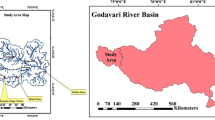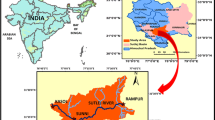Abstract
The study aims to examine the variation of hydrological processes (in terms of mean annual, seasonal, and monthly) under changing climate within the Weyib River basin in Ethiopia at both basin and sub-basin level using ArcSWAT hydrologic model. The climate change impacts on temperature and precipitation characteristics within the basin have been studied using GFDL-ESM2M, CanESM2, and GFDL-ESM2G models for RCP8.5, RCP4.5, and RCP2.6 scenarios from coupled model inter-comparison project 5 (CMIP5) which have been downscaled by SDSM. The results revealed that the mean annual temperature and precipitation reveal a statistically significant (at 5% significant level) increasing trend in the nine ESM-RCP scenarios for all the future time slices. The mean annual actual evapotranspiration, baseflow, soil water content, percolation, and water availability in the stream exhibit a rise for all the ESMs-RCP scenarios in the entire basin and in all the sub-basins. However, surface runoff and potential evapotranspiration show a decreasing trend. The mean annual water availability increases between 9.18 and 27.97% (RCP8.5), 3.98 and 19.61% (RCP4.5), and 11.82 and 17.06% (RCP2.6) in the entire basin. The sub-basin level analysis reveals that the annual, seasonal, and monthly variations of hydrological processes in all the sub-basins are similar regarding direction but different in magnitude as compared to that of the entire basin analysis. In addition, it is observed that there is a larger monthly and seasonal variation in hydrological processes as compared to the variation in annual scale. The net water availability tends to decline in the dry season; this might cause water shortage in the lowland region and greater increases in an intermediate and rainy seasons; this might cause flooding to some flood prone region of the basin. Since the variation of water availability among the sub-basins in upcoming period is high, there is a scope of meeting agriculture water demand through water transfer from sub-basin having more available water in small area to the sub-basin having less available water in a larger agricultural area.










Similar content being viewed by others
References
Aich V, Liersch S, Vetter T, Huang S, Tecklenburg J, Hoffmann P, Koch H, Fournet S, Krysanova V, Müller EN, Hattermann FF (2014) Comparing impacts of climate change on streamflow in four large African river basins. Hydrol Earth Syst Sci 18(4):1305–1321. https://doi.org/10.5194/hess-18-1305-2014
Alexandrov V, Genev M (2003) Climate variability and change impact on water resources in Bulgaria. Eur Water 12:25–30
Bates B, Kundzewicz Z, Wu S (2008) Climate change and water. Tech Pap Intergov Panel Clim Chang IPCC Secre 210. https://doi.org/10.1016/j.jmb.2010.08.039
Beck L, Bernauer T (2011) How will combined changes in water demand and climate affect water availability in the Zambezi river basin? Glob Environ Chang 21(3):1061–1072. https://doi.org/10.1016/j.gloenvcha.2011.04.001
Boko M, Niang I, Nyong A, et al (2008) Africa. Clim Chang 2007 Impacts, Adapt vulnerability Contrib Work Gr II to Fourth Assess Rep Intergov Panel Clim Chang 37(6)433–467. https://doi.org/10.2134/jeq2008.0015br
Brekke LD, Dettinger MD, Maurer EP, Anderson M (2008) Significance of model credibility in estimating climate projection distributions for regional hydroclimatological risk assessments. Clim Chang 89(3-4):371–394. https://doi.org/10.1007/s10584-007-9388-3
Conway D (2000) The climate and hydrology of the upper Blue Nile River linked references are available on JSTOR for this article : the climate and hydrology of the upper Blue Nile River. 166:49–62
Conway D, Hulme M (1993) Recent fluctuations in precipitation and runoff over the Nile sub-basins and their impact on main Nile discharge. Clim Chang 25(2):127–151. https://doi.org/10.1007/BF01661202
Conway D, Hulme M (1996) The impacts of climate variability and future climate change in the Nile basin on water resources in Egypt. Water Resour Dev 12:261–280
Dinar A (2006) District level hydro-climatic time series and scenario analysis to assess the impacts of climate change on regional water resources and agriculture in Africa. Discussion paper no. 13. Special series on climate change and agriculture in Africa, 60 pp. ISBN 1-920160-01-09
Ethiopian National Meteorological Agency (2007) Climate Change National Adaptation Programme of Action (Napa) of Ethiopia. 1–73pp
Faramarzi M, Abbaspour KC, Schulin R, Yang H (2009) Modelling blue and green water resources availability in Iran. Hydrol Process 23(3):486–501
Faramarzi M, Abbaspour KC, Ashraf Vaghefi S, Farzaneh MR, Zehnder AJB, Srinivasan R, Yang H (2013) Modeling impacts of climate change on freshwater availability in Africa. J Hydrol 480:85–101. https://doi.org/10.1016/j.jhydrol.2012.12.016
Farjad B, Gupta A, Marceau DJ (2016) Annual and seasonal variations of hydrological processes under climate change scenarios in two sub-catchments of a complex watershed. Water Resour Manag 30(8):2851–2865. https://doi.org/10.1007/s11269-016-1329-3
Gassman WP, Reyes MR, Green CH and Arnold J G (2005) SWAT peer-reviewed literature: a review, proceedings of the 3rd international SWAT conference, Zurich
Graham LP, Andersson L, Horan M, Kunz R, Lumsden T, Schulze R, Warburton M, Wilk J, Yang W (2011) Using multiple climate projections for assessing hydrological response to climate change in the Thukela River basin, South Africa. Phys Chem Earth 36(14-15):727–735. https://doi.org/10.1016/j.pce.2011.07.084
IPCC (2013) Climate change 2013: the physical science basis. Contribution of working group I to the fifth assessment report of the intergovernmental panel on climate change. Intergov panel Clim Chang work gr I Contrib to IPCC fifth assess rep (AR5)(Cambridge Univ press New York) 1535. https://doi.org/10.1029/2000JD000115
Johnson PA, Curtis PD (1994) Water balance of Blue Nile River basin in Ethiopia. J Irrig Drain Eng 120(3):573–589. https://doi.org/10.1061/(ASCE)0733-9437(1994)120:3(573)
Kebede S, Travi Y, Alemayehu T, Marc V (2006) Water balance of Lake tana and its sensitivity to fluctuations in rainfall, Blue Nile basin, Ethiopia. J Hydrol 316(1-4):233–247. https://doi.org/10.1016/j.jhydrol.2005.05.011
Kruger AC, Shongwe S (2004) Temperature trends in South Africa: 1960-2003. Int J Climatol 24(15):1929–1945. https://doi.org/10.1002/joc.1096
Loukas A, Sidiropoulos P, Mylopoulos N, et al (2015) Assessment of the effect of climate variability and change and human intervention in the lake Karla aquifer. 19–31
Maurer EP, Brekke L, Pruitt T, Duffy PB (2007) Fine-resolution climate projections enhance regional climate change impact studies. EOS Trans Am Geophys Union 88(47):504–504. https://doi.org/10.1029/2007EO470006
Monteith JL (1965) Evaporation and the environment. In the state and movement of water in living organisms, XIXth Symposium. Soc. For Exp. Biol., Swansea, Cam-bridge University Press. pp 205–234
Mpelasoka FS, Chiew FHS (2009) Influence of rainfall scenario construction methods on runoff projections. J Hydrometeorol 10(5):1168–1183. https://doi.org/10.1175/2009JHM1045.1
New M, Hewitson B, Stephenson DB, Tsiga A, Kruger A, Manhique A, Gomez B, Coelho CAS, Masisi DN, Kululanga E, Mbambalala E, Adesina F, Saleh H, Kanyanga J, Adosi J, Bulane L, Fortunata L, Mdoka ML, Lajoie R (2006) Evidence of trends in daily climate extremes over southern and west Africa. J Geophys Res Atmos 111(D14):1–11. https://doi.org/10.1029/2005JD006289
Pierce DW, Barnett TP, Santer BD, Gleckler PJ (2009) Selecting global climate models for regional climate change studies. Proc Natl Acad Sci 106(21):8441–8446. https://doi.org/10.1073/pnas.0900094106
Reichler T, Kim J (2008) How well do coupled models simulate today’s climate? Bull Am Meteorol Soc 89(3):303–311. https://doi.org/10.1175/BAMS-89-3-303
Serur AB, Sarma AK (2016) Evaluation of the ArcSWAT model in simulating catchment hydrology : in Weyib River basin, bale mountainous area of southeastern Ethiopia. Int J Innov Emerg Res Eng 3(2):3–11
Serur AB, Sarma AK (2017) Impact of spatial data availability on climate change prediction in the Weyib River basin in Ethiopia. Water Resour Manag 31(6):1809–1824. https://doi.org/10.1007/s11269-017-1613-x
Setegn SG, Srinivasan R, Melesse AM, Dargahi B (2010) SWAT model application and prediction uncertainty analysis in the Lake Tana Basin, Ethiopia. Hydrol Process 24(3):357–367
Setegn SG, Rayner D, Melesse AM, Dargahi B, Srinivasan R (2011) Impact of climate change on the hydroclimatology of Lake Tana Basin, Ethiopia. Water Resour Res 47(4):1–13. https://doi.org/10.1029/2010WR009248
Shawul AA, Alamirew T, Dinka MO (2013) Calibration and validation of SWAT model and estimation of water balance components of Shaya mountainous watershed, southeastern Ethiopia. Hydrol Earth Syst Sci Discuss 10(11):13955–13978. https://doi.org/10.5194/hessd-10-13955-2013
Shawul AA, Alamirew T, Melesse AM, Chakma S (2016) Climate change impact on the hydrology of Weyib River watershed, bale mountainous area, Ethiopia. In: landscape dynamics, soils and hydrological processes in varied climates, Springer international publishing, pp 587–613
Shongwe ME, Van Oldenborgh GJ, Van Den Hurk BJJM et al (2009) Projected changes in mean and extreme precipitation in Africa under global warming. Part I: southern Africa. J Clim 22(13):3819–3837. https://doi.org/10.1175/2009JCLI2317.1
Unganai LS (1996) Historic and future climatic change in Zimbabwe. Clim Res 6:137–145. https://doi.org/10.3354/cr006137
USDA-SCS (United States Department of Agriculture-Soil Conservation Service) (1972) National Engineering Handbook Section 4 hydrology, Chapters 4–10
Acknowledgements
This research did not receive any specific grant from funding agencies in the public, commercial, or not-for-profit sectors. The authors express their heartfelt gratitude to Meteorological Service Agency of Ethiopia forproviding us the meteorological data and Ministry of Water and Energy of Ethiopia for providing us the hydrological and spatial data to be considered for this study. The authors also would like to express their gratitude to the Editor-in-Chief and Anonymous Reviewer for their excellent suggestions, which will strengthen the paper.
Author information
Authors and Affiliations
Corresponding author
Rights and permissions
About this article
Cite this article
Serur, A.B., Sarma, A.K. Climate change impacts analysis on hydrological processes in the Weyib River basin in Ethiopia. Theor Appl Climatol 134, 1301–1314 (2018). https://doi.org/10.1007/s00704-017-2348-6
Received:
Accepted:
Published:
Issue Date:
DOI: https://doi.org/10.1007/s00704-017-2348-6




